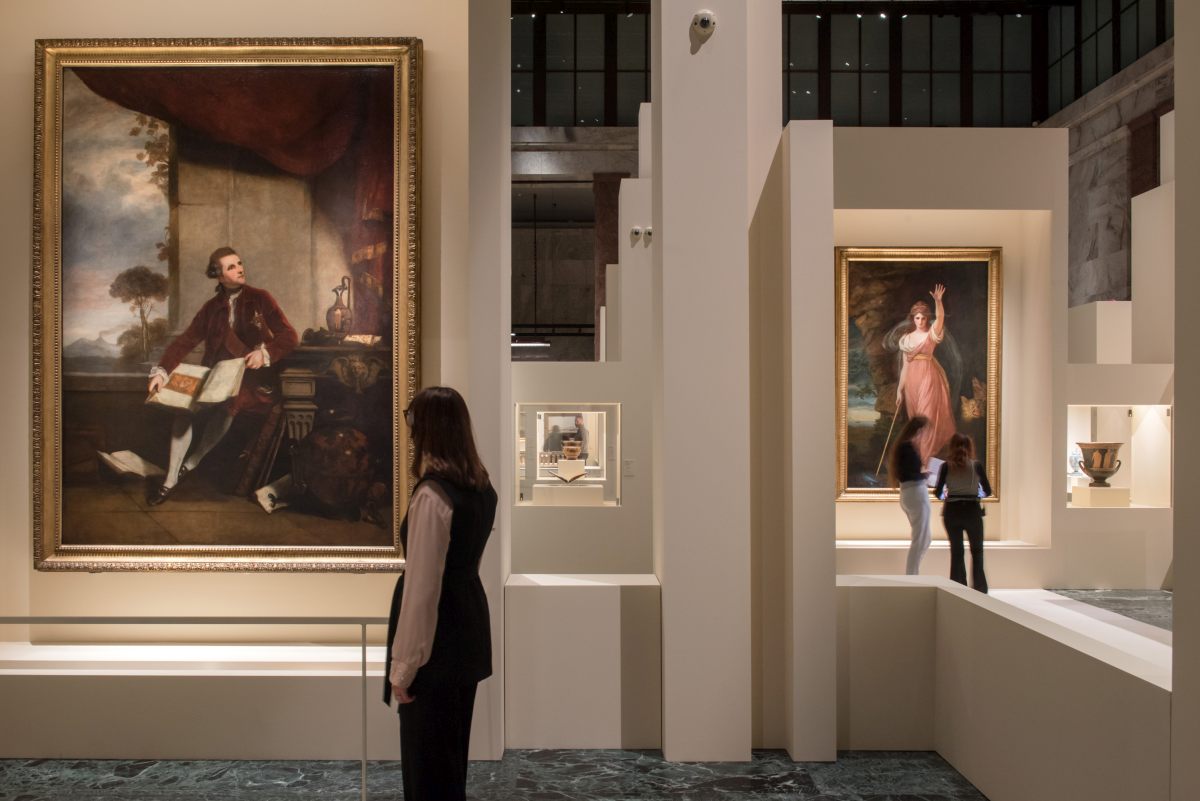NAPLES (ITALPRESS) – Intesa Sanpaolo opens to the public at the Gallerie d’Italia – Naples, from Oct. 25, 2024 to March 2, 2025, the exhibition “Sir William and Lady Hamilton,” curated by Francesco Leone and Fernando Mazzocca, dedicated to an extraordinary protagonist of the Neapolitan cultural world of the 18th century, William Hamilton, English ambassador to the court of Ferdinand IV of Bourbon, and the sometimes legendary figure of Lady Emma Hamilton.
The exhibition, organized with the support of the British Embassy in Rome and the Embassy of Italy in London and under the patronage of the City of Naples and the University of Naples Federico II, presents seventy-eight works including paintings, ceramics, sculptures and manufactures from important national and international museums, such as the Reggia di Caserta, Certosa and Museo di San Martino, National Portrait Gallery in London, Victoria & Albert Museum, Tate in London, The British Museum, Thyssen-Bornemisza in Madrid, the National Gallery of Art in Washington, as well as from private collections and galleries.
“The stories that arise from the immense cultural heritage of Naples are always exciting and linked to exceptional human events, just like what we are realizing today at the Gallerie d’Italia in Via Toledo,” says Michele Coppola, Executive Director Art, Culture and Historical Heritage Intesa Sanpaolo and General Director of the Gallerie d’Italia. “Telling the story of the collector Hamilton is a new tribute to the city, the result of the extraordinary dialogue with important institutions in Italy and abroad. This new original project once again confirms the cultural, civic and social contribution made by Intesa Sanpaolo thanks to the vitality of its museum headquarters, which is rightfully among the most active European museums.”
In the wake of the fundamental studies of Carlo Knight – who recently passed away – and the great 1996 exhibition at the British Museum, the exhibition reconsiders and enhances the human, political and intellectual story of Hamilton, a diplomat, antiquarian and volcanologist, who, with his multifaceted personality, found in the “enlightened” Naples of the second half of the 18th century fertile ground for affirming and developing his great passions: antiquity and science.
The sections through which the exhibition unfolds highlight his great interest in volcanology, landscape painting, music, and collecting, as well as the role he played in the Neapolitan society and social life of the time, amplified by the figure of Lady Emma Hamilton.
William Hamilton’s passion for antiquity resulted in the establishment of his own original collection of extraordinary painted Greek vases, some of which are featured in the exhibition, from Herculaneum, Pompeii, Southern Italy and Greece. The sale of part of this collection to the British Museum in 1772 played a decisive role on British antiquarian collecting and taste.
The exhibition illustrates his original initiative to produce and publish one of the most beautiful and famous illustrated books of all time, the magnificent Antiquitès etrusques, grecques et romaines. This was an exceptional set of five hundred engraved and decorated plates, hand watercolored in red and black with retouches in white and blue, reproducing the paintings found in the vases.
The texts for the volumes were compiled by the great and quirky scholar Pierre-François Hugues d’Hancarville, who at first enlisted the help of Johann Joachim Winckelmann. With this publication Hamilton also intended to offer models to contemporary artists, making vase painting the main source of inspiration for the so-called “linear style” that characterized the most experimental and original artists of Neoclassicism, such as the celebrated sculptor and illustrator John Flaxman and Josiah Wedgwood, owner of the eponymous manufactories.
A substantial part of the exhibition is devoted to the figure of Lady Hamilton. After the demise in 1782 of his first wife, Hamilton became a leading figure in the most exclusive society thanks to his second marriage to Emily Lyon, better known as Emma Hart (Neston, 1765 – Calais, 1815), the celebrated adventuress who also had great influence politically through her ties with Queen Mary Caroline and her scandalous affair with the famous Admiral Horatio Nelson. The magnificent portraits in the exhibition by Englishman George Romney and German Johann Heinrich Wilhelm Tischbein restore the glamour of Emma, who was also depicted by other painters of the time in the guise of figures of classicism and myth. Thus was nurtured the image of a woman destined to enter legend for her dazzling beauty, her wit and the unprejudiced freedom of her costumes. She then became famous for her “attitudes,” or the suggestive poses she assumed while representing tableaux vivants for her guests where she evoked the gods and heroines of the classical world.
The exhibition also features the screening of a video made by the Fondazione Cineteca Italiana that collects the film images that best tell the story and myth of Lady Hamilton.
Another important part of the exhibition addresses the theme of travel. A decisive moment in Hamilton’s life was the visit to him in 1787 by Johann Wolfgang Goethe during his famous Journey to Italy. The ambassador was also a great traveler: he ventured into the then impractical and unsafe territories of Calabria and Sicily, driven by his curiosity and scientific passion for exceptional natural phenomena such as volcanoes and telluric movements. Exceptional evidence of these interests remains in another celebrated publishing venture he promoted, the publication of volumes entitled Campi Phlegraei published in Naples in 1776, to which was added in 1779 a supplement with an Account of the Great Eruption of Mount Vesuvius, a work illustrated by a team led by the painter Pietro Fabris, who was his companion on excursions to the slopes of Vesuvius and Mount Etna.
The hand-colored illustrations in these volumes document Hamilton’s expertise in volcanology, investigated in all its aspects, from eruptive phenomena to all the morphological peculiarities of the territories he explored. This scientific vocation and interest in nature led him to become a promoter and collector of landscape painting.
The exhibition privileges his special relationship with the great Roman vedutista Giovanni Battista Lusieri and with the more experimental and modern English painters such as Joseph Wright of Derby, Thomas Jones, and John Robert Cozens, whom he hosted and encouraged. It was also thanks to his efforts that Naples became a major workshop in the creation of the modern landscape.
The exhibition catalog is produced by Edizioni Gallerie d’Italia | Skira.
The Naples museum, along with those in Milan, Turin and Vicenza, is part of Intesa Sanpaolo’s Gallerie d’Italia museum project, led by Michele Coppola, the bank’s Executive Director Art, Culture and Historical Assets and General Director of the Gallerie d’Italia.
– Intesa Sanpaolo press office photo –
(ITALPRESS).

